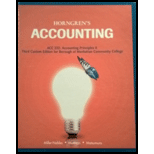
Concept Introduction:
Relevant or avoidable costs and Irrelevant or unavoidable costs –
The major decisions that a business has to take during its operations include dropping of a product, elimination of a segment, buy or make a product, to sell at scrap or rework on the product, to accept special offers etc. All these decisions are taken on the basis of the costs involved. There are two types of costs –
1. Relevant costs or avoidable costs – these costs can be defined as the costs that can be avoided if we choose over option over the other. Example of relevant costs are, direct material, direct labor, avoidable fixed costs etc.
2. Irrelevant costs – these costs can be defined as the costs that cannot be avoided in any of the options available or the costs which have been already incurred like sunk costs. Examples of irrelevant costs are unavoidable fixed costs, or the costs which have been already incurred.
To analyse:
Should Daniels sell the software as it is or develop it further?
Want to see the full answer?
Check out a sample textbook solution
Chapter 25 Solutions
ACCOUNTING PRINCIPLES 222 5/16 >C<
- A business purchased supplies on credit. What is the effect of this transaction on the accounting equation? a. Increase one asset and decrease another asset b. Increase an asset and increase a liability c. Decrease an asset and decrease a liability d. Increase an asset and increase owner's equityarrow_forwardAt the beginning of the year, Bright Mart Inc. reported cash of $35 million, and by the end of the year, it was $27 million. The company's statement of cash flows reported cash from operating activities of $80 million and cash from investing activities of -$45 million. What amount (in $ millions) did the company report for cash from financing activities?arrow_forwardNonearrow_forward
- The standard cost card for one unit of a certain finished product shows the following: Standard Quantity or Standard Price or Hours Rate Direct materials 10 pounds $? per pound Direct Labor 2.5 hours $16 per hour Variable manufacturing 1.5 hours $10 per hour overhead If the total standard variable cost for one unit of finished product is $85, then the standard price per pound for direct materials is: A. $5.90 B. $1.74 C. $3.00 D. $4.60arrow_forwardGeneral accounting questionarrow_forwardI need help with this problem is accountingarrow_forward

 AccountingAccountingISBN:9781337272094Author:WARREN, Carl S., Reeve, James M., Duchac, Jonathan E.Publisher:Cengage Learning,
AccountingAccountingISBN:9781337272094Author:WARREN, Carl S., Reeve, James M., Duchac, Jonathan E.Publisher:Cengage Learning, Accounting Information SystemsAccountingISBN:9781337619202Author:Hall, James A.Publisher:Cengage Learning,
Accounting Information SystemsAccountingISBN:9781337619202Author:Hall, James A.Publisher:Cengage Learning, Horngren's Cost Accounting: A Managerial Emphasis...AccountingISBN:9780134475585Author:Srikant M. Datar, Madhav V. RajanPublisher:PEARSON
Horngren's Cost Accounting: A Managerial Emphasis...AccountingISBN:9780134475585Author:Srikant M. Datar, Madhav V. RajanPublisher:PEARSON Intermediate AccountingAccountingISBN:9781259722660Author:J. David Spiceland, Mark W. Nelson, Wayne M ThomasPublisher:McGraw-Hill Education
Intermediate AccountingAccountingISBN:9781259722660Author:J. David Spiceland, Mark W. Nelson, Wayne M ThomasPublisher:McGraw-Hill Education Financial and Managerial AccountingAccountingISBN:9781259726705Author:John J Wild, Ken W. Shaw, Barbara Chiappetta Fundamental Accounting PrinciplesPublisher:McGraw-Hill Education
Financial and Managerial AccountingAccountingISBN:9781259726705Author:John J Wild, Ken W. Shaw, Barbara Chiappetta Fundamental Accounting PrinciplesPublisher:McGraw-Hill Education





